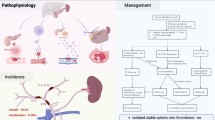Abstract
Cavernous hemangiomas of the spleen are small benign lesions found incidentally, majority of times while patients are being investigated for some other disease and patients remain asymptomatic otherwise for this condition. The natural history of cavernous hemangiomas of spleen is slow, symptoms or complications, when present, occur late, they are rarely large and can manifest as a palpable non-tender mass in the left upper quadrant. A very rare syndrome is associated with this condition called Kasabach–Merritt syndrome (KMS), which is defined as diffuse cavernous hemangioma of the spleen alongwith anemia, thrombocytopenia, and coagulopathy. Perioperative diagnosis can be confirmed by imaging study which can be CT, MRI, or ultrasound. Splenectomy is considered the treatment of choice for such patients with symptoms. To our knowledge, a very few cases have been reported so far. The purpose of writing this review article is the reporting of this rare case and to provide some experience related to the management of this condition in a patient with KMS.




Similar content being viewed by others
References
D.H. Lawrence. Lady Chatterley’s lover. Published October 31st 2006 by Penguin Classics (first published 1928).014303961X (ISBN13: 9780143039617)
Abbott RM, Levy AD, Aguilera NS, Gorospe L, Thompson WM (2004) From the archives of the AFIP: Primary vascular neoplasms of the spleen: radiologic-pathologic correlation. Radiographics 24:1137–1163
Marsden PD, Hamilton PJS (1969) Splenomegaly in the tropics; medicine in the tropics. Brit med J 1:99–102
O’Reilly RA (1998) Splenomegaly in 2,505 patients at a large university medical center from 1913 to 1995. 1913 to 1962: 2,056 patients. West J Med 169:78–87
Sundaresan JB, Dutta TK, Badrinath S, Jagdish S, Basu D.A hospital-based study of splenomegaly with special reference to the group of indeterminate origin. J Indian Med Assoc. 2008 Mar;106(3):150, 152, 154 passim. PMID: 18712133
Pottakkat B, Kashyap R, Kumar A, Sikora SS, Saxena R, Kapoor VK (2006) Redefining the role of splenectomy in patients with idiopathic splenomegaly. ANZ J Surg 76(8):679–682
Abbott RM, Levy AD, Aguilera NS, Gorospe L, Thompson WM. From the archives of the AFIP: primary vascular neoplasms of the spleen: radiologic-pathologic correlation. Radiographics 2004; 24:1137–63. PMID:15256634
Disler DG, Chew FS (1991) Splenic hemangioma. Am J Roentgenol 157:44
Garvin DF, King FM (1981) Cysts and nonlymphomatoustumours of the spleen. Pathol Annu 16:61–80
Pinkhas J, Djaldetti M, de Vries A, Sarfa D, Dollberg L (1968) Diffuse angiomatosis with hypersplenism: Splenectomy followed by polycythemia. Am J Med 45:795–801
Kasabach HH, Merritt KK : Capillary hemangioma with extensive purpura : report of a case . Am J Dis Child : 1063–70, 1940
Hall GW (2001) Kasabach-Merritt syndrome; pathogenesis and management. Br J Haematol 112:851–862
Poetke M, Jamil B, Müller U, Berlien HP (2002) Diffuse neonatal hemangiomatosis associated with Simpson-Golabi-Behmelsyndrome: a case report. Eur J Pediatr Surg 12:59–62
Sencer S, Coulter-Knoff A, Folker J, Thompson T, Burke B (1987) Splenic hemangioma with thrombocytopenia in newborn. Pediatrics 79(6):960–966
Szlachetka DM (1998) Kasabach-Merritt syndrome: a case review. Neonatal Netw 17:7–15
Demircan O, Demiryurek H, Yagmur O (2005) Surgical approach to symptomatic giant cavernous hemangioma of the liver. Hepato-Gastroenterology 52:183–186
Steininger H, Pfofe D, Marquardt L, Sauer H, Markwat R (2004) Isolated diffuse hemangiomatosis of the spleen: case report and review of literature. Pathol Res Pract 200:479–485
Watanabe Y, Looi CY, Onumo M, Saito Y, Kitazawa H, Niizuma H, Rikiishi T, Sakamoto O, Sasahara Y, Kumaki S, Watanabe M, Usio S, Tsuchiya S (2011) Vincristine-resistant Kasabach–Merritt phenomenon successfully treated with low dose radiotherapy. Int J Hematol 201193:126–128
Conflict of Interest
None.
Funding
None.
Author information
Authors and Affiliations
Corresponding author
Rights and permissions
About this article
Cite this article
Haque, P.D., Mahajan, A., Chaudhary, N.K. et al. Kasabach–Merritt Syndrome Associated With a Large Cavernous Splenic Hemangioma Treated With Splenectomy: A Surgeon’s Introspection of an Uncommon, Little Read, and Yet Complex Problem—Review Article. Indian J Surg 77 (Suppl 1), 166–169 (2015). https://doi.org/10.1007/s12262-015-1232-9
Received:
Accepted:
Published:
Issue Date:
DOI: https://doi.org/10.1007/s12262-015-1232-9




